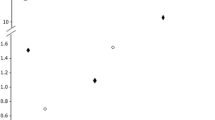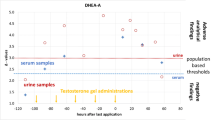Abstract
When testing a urine sample for testosterone abuse, a ratio of testosterone glucuronide (T) to epitestosterone glucuronide (ET) of 4.0 or above is considered suspicious. A degree of variation, however, has been observed in T/ET ratio between individuals from both the same and different ethnic backgrounds. The majority of this variation might be due to UGT2B17 deletion genotype (UGT2B17 deletion-type). The aim of this study was to investigate the use of the same urine sample for the analysis of T/ET ratio and UGT2B17 deletion-type. Japanese men were deletion-typed via a UGT2B17 copy number assay using DNA from blood. Urinary T and ET levels were determined using gas chromatography–mass spectrometry before (n = 112) and after a testosterone injection (n = 25). Basal T level and the increase in T/ET ratio after injection were dependent on UGT2B17 deletion-type, being lower in subjects with deletion (del/del) than nondeletion (ins/del or ins/ins) genotype. UGT2B17 deletion-typing was first performed using DNA from urine cryopreserved for 1–1.5 years (n = 66). The concentration of DNA required for discrimination between the deletion and nondeletion genotype by copy number assay was more than 0.1 ng/ml urine. Discrimination was possible in 94.0 % of urine samples (5–7 ml each). These findings show that T/ET ratio and UGT 2B17 deletion-type can be analyzed exclusively via urine samples, removing the need for the collection of other samples, such as blood or buccal cells. The combination of T/ET ratio and UGT 2B17 deletion-type may help inform decisions regarding a genotype-specific T/ET cutoff ratio.




Similar content being viewed by others
References
Dehennin L, Delgado A, Pérès G (1994) Urinary profile of androgen metabolites at different stages of pubertal development in a population of sporting male subjects. Eur J Endocrinol 130:53–59
Borts DJ, Bowers LD (2000) Direct measurement of urinary testosterone and epitestosterone conjugates using high-performance liquid chromatography/tandem mass spectrometry. J Mass Spectrom 35:50–61
Sten T, Bichlmaier I, Kuuranne T, Leinonen A, Yli-Kauhaluoma J, Finel M (2009) UDP-glucuronosyltransferases (UGTs) 2B7 and UGT2B17 display converse specificity in testosterone and epitestosterone glucuronidation, whereas UGT2A1 conjugates both androgens similarly. Drug Metab Dispos 37:417–423
Turgeon D, Carrier JS, Lévesque E, Hum DW, Bélanger A (2001) Relative enzymatic activity, protein stability, and tissue distribution of human steroid-metabolizing UGT2B subfamily members. Endocrinology 142:778–787
Kicman AT, Oftebro H, Walker C, Norman N, Cowan DA (1993) Potential use of ketoconazole in a dynamic endocrine test to differentiate between biological outliers and testosterone use by athletes. Clin Chem 39:1798–1803
Raynaud E, Audran M, Pagès JC, Fédou C, Brun JF, Chanal JL, Orsetti A (1993) Determination of urinary testosterone and epitestosterone during pubertal development: a cross-sectional study in 141 normal male subjects. Clin Endocrinol (Oxf) 38:353–359
Dehennin L (1994) On the origin of physiologically high ratios of urinary testosterone to epitestosterone: consequences for reliable detection of testosterone administration by male athletes. J Endocrinol 142:353–360
Schulze JJ, Lundmark J, Garle M, Skilving I, Ekström L, Rane A (2008) Doping test results dependent on genotype of uridine diphospho-glucuronosyl transferase 2B17, the major enzyme for testosterone glucuronidation. J Clin Endocrinol Metab 93:2500–2506
Juul A, Sørensen K, Aksglaede L, Garn E, Meyts Rajpert-De, Hullstein I, Hemmerbach P, Ottesen AM (2009) A common deletion in the uridine diphosphate glucuronyltransferase (UGT) 2B17 gene is a strong determinant of androgen excretion in healthy pubertal boys. J Clin Endocrinol Metab 94:1005–1011
Jakobsson J, Ekström L, Inotsume N, Garle M, Lorentzon M, Ohlsson C, Roh HK, Carlström K, Rane A (2006) Large differences in testosterone excretion in Korean and Swedish men are strongly associated with a UDP-glucuronosyl transferase 2B17 polymorphism. J Clin Endocrinol Metab 91:687–693
Murata M, Warren EH, Riddell SR (2003) A human minor histocompatibility antigen resulting from differential expression due to a gene deletion. J Exp Med 197:1279–1289
Wilson W 3rd, Pardo-Manuel de Villena F, Lyn-Cook BD, Chatterjee PK, Bell TA, Detwiler DA, Gilmore RC, Valladeras IC, Wright CC, Threadgill DW, Grant DJ (2004) Characterization of a common deletion polymorphism of the UGT2B17 gene linked to UGT2B15. Genomics 84:707–7113
Strahm E, Sottas PE, Schweizer C, Saugy M, Dvorak J, Saudan C (2009) Steroid profiles of professional soccer players: an international comparative study. Br J Sports Med 43:1126–1130
Okano M, Ueda T, Nishitani Y, Kano H, Ikekita A, Kageyama S (2013) UDP-glucuronosyltransferase 2B17 genotyping in Japanese athletes and evaluation of the current sports drug testing for detecting testosterone misuse. Drug Test Anal 5:166–181
Sołtyszewski I, Pepiński W, Dobrzyńska-Tarasiuk A, Janica J (2006) DNA type ability in liquid urine and urine stains using AmpFISTR SGM Plus. Adv Med Sci 51:36–38
Cannas A, Kalunga G, Green C, Calvo L, Katemangwe P, Reither K, Perkins MD, Maboko L, Hoelscher M, Talbot EA, Mwaba P, Zumla AI, Girardi E, Huggett JF (2009) Implications of storing urinary DNA from different populations for molecular analyses. PLoS One 4:1–8
Kikuchi H, Uchiyama N, Ogata J, Kikura-Hanajiri R, Goda Y (2010) Chemical constituents and DNA sequence analysis of a psychotropic herbal product. Forensic Toxicol 28:77–83
Sasao A, Suwa Y, Aso T, Komatsu H, Ohtsu Y, Mishima S, Yonemitsu K, Morioka H, Nishitani Y (2013) Single-chain variable fragment technology in forensic toxicological analysis: production of an antibody to fluvoxamine. Forensic Toxicol 31:62–66
Yamaori S, Kushihara M, Koeda K, Yamamoto I, Watanabe K (2013) Significance of CYP2C9 genetic polymorphism in inhibitory effect of Δ9-tetrahydrocannabinol on CYP2C9 activity. Forensic Toxicol 31:70–75
Donike M (1993) Steroid profiling in Cologne. In: Donike M, Geyer H, Goltzmann A, Mareck-Engelke U, Rauth S (eds) Proceedings, 10th Cologne workshop on dope analysis. Sport and Buch Strauβ, Cologne, pp 47–68
Nakahara H, Fujii K, Mizuno N, Yoshida K, Kasai K (2007) Evaluation of DNA quantification methods for forensic biological samples. Jpn J Forensic Sci Technol 12:13–26
Dubois SG, Beaulieu M, Lévesque E, Hum DW, Bélanger A (1999) Alteration of human UDP-glucuronosyltransferase UGT2B17 regio-specificity by a single amino acid substitution. Mol Biol 289:29–39
Sten T, Kurkela M, Kuuranne T, Leinonen A, Finel M (2009) UDP-Glucuronosyltransferases in conjugation of 5α-and 5β-androstane steroids. Drug Metab Dispos 37:2221–2227
Swanson C, Mellström D, Lorentzon M, Vandenput L, Jakobsson J, Rane A, Karlsson M, Ljunggren O, Smith U, Eriksson AL, Bélanger A, Labrie F, Ohlsson C (2007) The uridine diphosphate glucuronosyltransferase 2B15 D85Y and 2B17 deletion polymorphisms predict the glucuronidation pattern of androgens and fat mass in men. J Clin Endocrinol Metab 92:4878–4882
Deelman LE, van der Wouden EA, Duin M, Henning RH (2002) A method for the ultra rapid isolation of PCR-ready DNA from urine and buccal swabs. Mol Biol Today 3:51–54
Acknowledgments
This study was entirely supported by a grant from the Japan Sport Council.
Conflict of interest
There are no financial or other relations that could lead to a conflict of interest.
Author information
Authors and Affiliations
Corresponding author
Rights and permissions
About this article
Cite this article
Aoki, K., Shinohara, H., Tanaka, H. et al. Steroid profile analysis and UGT2B17 genotyping of the same urine sample to determine testosterone abuse. Forensic Toxicol 32, 194–200 (2014). https://doi.org/10.1007/s11419-013-0220-7
Received:
Accepted:
Published:
Issue Date:
DOI: https://doi.org/10.1007/s11419-013-0220-7




